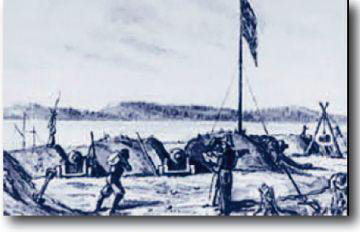
Chapter 13:
Bombardment at the White House

On August 27, 1814, three days after the capture of Washington, D.C., a British squadron appeared before Fort Washington. It consisted of one frigate of 36 guns, one of 38 guns, two rocket ships, two bomb vessels, and one schooner. The American Captain Dyson either misunderstood General Winder’s order to repel or was in mortal fear, for he blew up and abandoned the fort without firing a gun. There is little doubt that the British fleet could have been kept below by the proper employment of the fort’s heavy cannon—but Dyson chose not to fight and for his conduct he was dismissed from the service.
The British squadron now had nothing to fear and sailed upriver, anchoring off Alexandria on the 28th. The following morning, the squadron positioned its ships into a bombardment formation 100 yards from the wharves and prepared to level the town. The able-bodied men and their heavy guns had been sent from the fort to defend the city but not more than 100 men were left.
When the British squadron arrived there was little means to oppose, so the city sent a delegation to Commodore Gordon to ask what terms he would ask to spare the town. He replied that all naval stores and ordnance—all the shipping and its furniture, merchandise of every description in the city, and “refreshments” of every kind—must immediately be given up to him. (There was a good reason for demanding furniture—the British naval captains were running a furniture business selling American cabinetry to other ship Captains.) In addition, he demanded that the vessels the Americans had scuttled be raised and delivered to the British. If all of this was done, the town and the citizens would be spared, except for the public works.
The British allowed only one hour for a response to these harsh and humiliating terms—not nearly enough time for the Americans to comply, even if they so chose. The merchandise that had already been carried from the town, as well as the sunken vessels, could not be given up.
So the British burned one vessel and loaded five captured ships and other craft with 16,000 pounds of flour, 150 bales of cotton, 1,000 hogsheads of tobacco and 5,000 dollars worth of wine and cigars. The squadron, now a fleet, weighed anchor and sailed down the Potomac.
Upon hearing of the surrender of Alexandria, the U.S. government determined to capture or destroy the British squadron on its descent of the Potomac. The Maryland and District militia could not be rallied in time, so the Secretary of the Navy sent an order to Commodore Rodgers in Baltimore to hurry with as large a number of Marines and sailors as he could assemble. Fifty Marines and 400 seamen, along with four 12-pounder cannon, were placed under the command of Commodores Rodgers, Perry, Porter and Creighton. Armed boats and fire-ships were prepared and these, along with the Marines and sailors—accompanied by the Virginia militia—were able to give the enemy a great deal of trouble.
Batteries were placed on the river bank at the White House, a short distance below Mount Vernon, and at Indian Head, Maryland. Both positions were commanding points on opposite sides of the river. Musketmen were placed on the wooded shores. Cannon were taken up by volunteers and quickly placed in battery. For five days, from September 1, they kept the British and their plundered vessels from descending the river. Meanwhile, the batteries and militia were supported by more cannon sent down from Washington and all the men that could be mustered from neighboring counties. The fighting became heavy.
The British employed a creative tactic. They were able to elevate their ships’ guns by lowering the breeches and cutting away the gun ports so they could bear on the high bluffs. Finally their ten war vessels, with a total of 173 guns, brought such concentrated fire on Porter’s battery at the White House and its supports, that it drove the Americans away. Perry’s battery at Indian Head experienced a similar fate. His guns, managed by Lt. George Read, were also overwhelmed and the British were able to pass on to Chesapeake Bay.
Thus ended the British invasion which resulted in the capture of Washington, the destruction of its public buildings and Navy Yard, the surrender and plunder of Alexandria, and the profound humiliation of the American people. But in slowing the British advance down the Potomac, the Marines had demonstrated that their skills at the cannon could be instrumental in battle—and fortunately, better days were ahead.

Potomac River showing earthworks erected by David Porter against the British squadron in September 1814